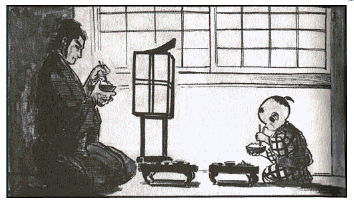A friend of mine got me buying these when First Comics first released issues of this saga (out of order and far from complete) in the late 80s/early 90s. They were cool, in a samurai, chop-em-up kind of way.
And now, he came back to town with the new Dark Horse reprints - in order, in manga style release, with accompanying glossaries and essays in the back of each issue.
And they're absolutely brilliant. The series starts out as a typical Yojimbo/Fistful of Dollars-who's-the-baddest-bastard action story, but twists its way into something entirely above that.
Plot, pacing, character - gorgeous landscapes (watercolor?) - cinematic pans, dollies, crossfades... and lectures, both verbal and visual, on religious concepts like "mu," or elements of Confucianism and the bushido code.
The code is everything in Lone Wolf & Cub - and it's a lot more complex than you might expect. The code makes them monsters, and they embrace that.
Anyone else blown away by these things? It might help that I've gotten all of them as a big stack and am reading them day and night.

On the net, I've found this interview with the creators, Kazuo Koike & Goseki Kojima, done by their biggest fan in American comics, Frank Miller. It's from 1987.
------------------
excerpt: FRANK: What struck me first about your artwork on LONE WOLF was the combat scenes, so full of motion and power. You seem to break the figures into streaks, emphasizing movement over the careful depiction of form. I wish I could sit with you and talk about this in person, since among the many virtues of your work, it is the one that has affected me the most profoundly, but since I can't, let me ask you to speak on this most thrilling and original aspect of your work. Was this the product of careful theory, or did it seem to you, from the beginning, the only proper way to capture the grace and speed of warriors in combat?
KOJIMA: You draw the picture by your own nerve. You have to be a Lone Wolf. Every human being is not created equal. Comics can't be taught in school. Of course, you will use your arm best but -- if I must -- I don't mind using my foot. Absolutely and entirely, it will depend upon your expressive nerve. Even if you become my assistant for 20 years, you will only be a copy man. The publisher often comments to young artists, "bring your individual character!" But that's easy because everyone has that. I know a brilliant comic artist who became an assistant to a famous artist, and now the master gives him a direction and everyone else copies from the chief assistant. The creativity stops right there, all the pictures start to level off the same.
In my case, I draw alone at the edge, fearing that someone, some day, will surpass me. So, naturally my drawing has a tendency for the growth momentum. If I ever wear down, the pictures will become dull and low tone. Even my publisher will try to pursue me -- it will be my time to resign. I'll be worn out. So you must be kidding. I can't draw the picture the same all the time. In fact, my problem is how to draw a character continuously the same throughout the story!
KOIKE: Also, Japanese comics move in a frame. The eye moves in Japanese comics. That's the fundamental difference between Japanese and American comics. American comics have a tendency to stay within a frame, and a frame stands individually. Japanese comics have a tendency for one frame to interfere with the next frame, running sequentially. When Superman flies in the sky, if it's drawn in one single frame, that's a still picture. In Japanese comics, a character will fly in three frames while focused on head, body, and foot. That's, I should say, the difference of production point-of-view, and I think without changing such a view of basic principles, American comics will face further decline.
-----------------------
The following two-page image sums it up nicely. The text is all but unreadable, but basically Itto Ogami is explaining to his three-year-old son Daigoro (named for "Daiga" or "enlightenment") how if either of them die, they are to look to the moon, to eliminate the difference between the self and moon, and their lost person will be there:

Check it out. |